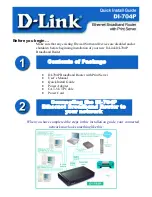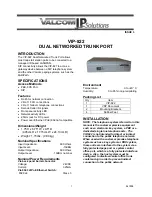
137
6620-3201
Remote access options:
The Remote access options parameter can be set to “No restrictions”, “Disable management”,
“Disable return RST”, “Disable management & return RST”. When set to “No restrictions”, users on
this interface can access the unit’s Telnet, FTP and web services for the purpose of managing the
unit.
When set to “Disable management”, users on this interface are prevented from managing the unit
via Telnet, FTP or the web interface.
Disable return RST - whenever a unit receives a TCP SYN packet for one of it’s own IP addresses
with the destination port set to an unexpected value, i.e. a port that the unit would normally expect
to receive TCP traf
fi
c on, it will reply with a TCP RST packet. This is normal behaviour.
However, the nature of internet traf
fi
c is such that whenever an internet connection is established,
TCYP SYN packets are to be expected. As the router’s PPP inactivity timer is restarted each time the
unit transmits data (but not when it receives data), the standard response of the unit to SYN packets,
i.e. transmitting an RST packet, will restart the inactivity timer and prevent the unit from disconnecting
the link even when there is no “genuine” traf
fi
c. This effect can be prevented by using the appropriate
commands and options within the
fi
rewall script. However, on Westermo 1000 series units, or where
you are not using a
fi
rewall, the same result can be achieved by selecting this option, i.e. when this
option is selected the normal behaviour of the unit in responding to SYN packets with RST packets
is disabled. The option will also prevent the unit from responding to unsolicited UDP packets with the
normal ICMP destination unreachable responses.
The “Disable management & return RST” option prevents users from managing the unit via the Telnet,
FTP and web interfaces and also disables the transmission of TCP RST packets as above.
Dial-out prefi x:
When making outgoing PPP calls, the value speci
fi
ed by the Dial-out Pre
fi
x parameter is inserted at
the started of the actual number being called. This is normally used to access an outside line. For
example, when using AODI or BACP, the remote peer may provide a number to be used for raising
an additional B-channel to increase bandwidth. However, such a number will not normally include the
digits needed to connect to an outside line via a PABX.
Dial-out number:
To allow the unit to automatically make outgoing PPP calls you must enter the ISDN number to dial in
the Dial-out Number
fi
eld. This might be the number of your Internet Service Provider (ISP) or another
router for example.
Use GPRS/PSTN/external modem:
On models
fi
tted with a GPRS module the PPP instance can be con
fi
gured to use either GPRS, PSTN
or an external modem (connected via one of the ASY ports) instead of ISDN.
Detach GPRS on link failure:
If this parameter is set to “Yes”’, a GPRS PPP connection will detach and reattach after a failed PPP
connection disconnects. A PPP connection is deemed to have failed if the PPP was disconnected due
to a
fi
rewall request, or if the PPP PING response timer expires.
Detach GPRS between connection attempts:
When this parameter is set to “Yes” the GPRS module will always detach (and reattach) between PPP
connections.
Username:
This is the username that should be used when authenticating with the remote system and is usually
only required for outgoing PPP calls.
Password (Empty):
This is the password that should be used when authenticating with the remote system and is usually
only required for outgoing PPP calls.
















































